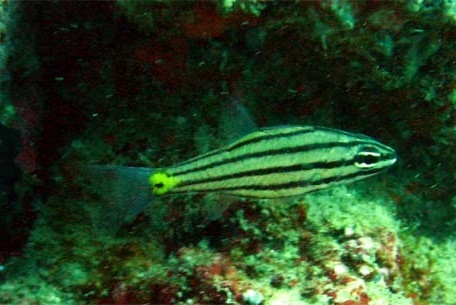Cheilodipterus isostigmus

| Latin name | Cheilodipterus isostigmus - (Schultz, 1940) |
|---|---|
| Local name | Dog-toothed cardinalfish |
| Family | Apogonidae - Cheilodipterus |
| Origin | East Indian Ocean, West Indian Ocean, Australia, Indonesia, East Pacific, Central/West Pacific |
| Max length | 11 cm (4.3") |
| Minimum volume |
100 l (26 gal) |
|---|---|
| Hardiness |
Hardy |
| Suitable for aquarium |
Suitable for most aquarium |
| Reef safe |
Reef safe with caution |
| Aggressiveness | Docile but might be aggressive towards similar species |
| Recommended |
Small crustaceans (Krill, mysis, artemia...) Zooplankton (Cyclops, pods...) |
|---|---|
| Maybee |
Larger crustaceans (Shrimp, crabs...) |
This spicies might be a threat to smaller fishes.
This species poses a threat towards shrimps and crabs etc., which are relatively small.
This species must be fed with an appropriately varied diet.
There is a greater chance of success with this species if one can supply a living feed to allow it to adapt to the tank.
This species will better acclimatize to the aquarium`s condition if introduced, when young.
Very small individuals can be very delicate.
Out in wild this species is used to faint light, so to acclimitize it, it is advantageous to dim the light at first and gradually increase it to normal.
This species thrives best in a pair. (Male and female)
This species needs good hiding places, for example, between live rocks.
This species is nocturnal and therefore the most active when the light is dimmed or turned off.
This species is very shy and docile, so one should be careful when keeping it with more aggressive fish.
Cardinalfish come in many different shapes and colours, generally they are well suited for aquaria.
Cardinalfish have a large mouth and a big appetite, take this into account with feeding the other fish. These fish typically live off of Artemia, Mysis and krill. In the aquarium they will eat anything they can.
They will sometimes eat small shrimps and fish, so do be aware of this, but it is not normally a problem.
It is possible to keep several species together, if space allows. Some species will form small shoals. They are normally peaceful towards other fish, but will sometimes fight among themselves if there isn't sufficient space or food.
Many species are nocturnal and will therefore often seek a hiding place during the day. This can be between stones, SPS corals and, in some cases, in an anemone and between spines of Sea urchins.
Cardinalfish are a good choice if ones wishes to attempt to start a breeding tank.
| Aquarium trade | No |
|---|---|
| Distribution | Indo-Pacific: Maldives, Philippines and Palau south to Indonesia; east to Tonga . Also in Moluccas, Belau, and Caroline (Ref. 1602). |
| English common names |
Toothy cardinalfish Dog-toothed cardinalfish |
Henry C. Schultz. 2004. Cardinals Not Named Pujols, Womack, or Edmonds: The Genus Cheilodipterus - Reefkeeping Magazine - (English)
Scott W. Michael. 2001. Basslets, Dottybacks & Hawkfishes: v. 2 (Reef Fishes) - TFH Publications / Microcosm Ltd. - (English)
Bob Fenner. Cardinalfishes, Family Apogonidae, Pt. 1, Pt. 2 - Wet Web Media - (English)

